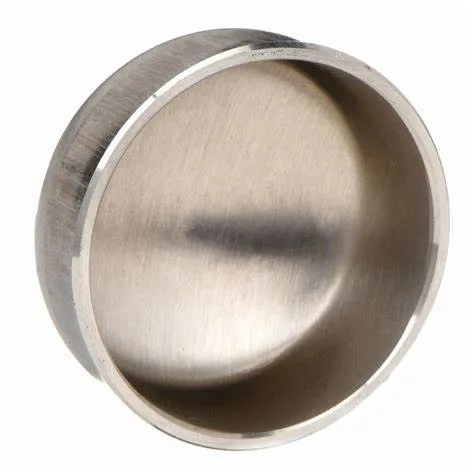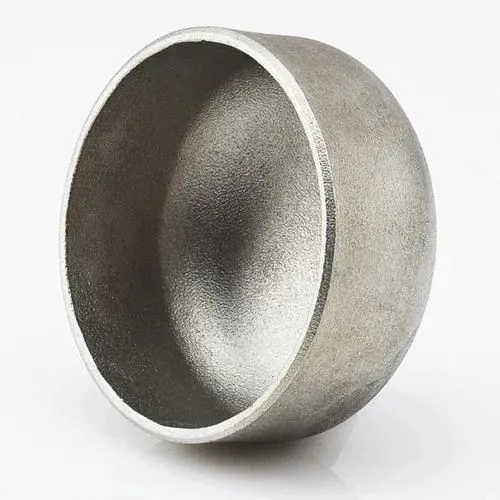JIS B2311 estas Japana Industria Normo, kiu kovras pugoveldajn tubojn, inkluzive de ĉapoj uzataj en tubaj sistemoj. Pug-veldaj ĉapoj servas la celon de fermado de la fino de pipo, disponigante sigelon por malhelpi elfluadon aŭ poluadon. Jen enkonduko al JIS B2311 pugoveldaj ĉapoj:
- 1. JIS B2311 Standard:
- - JIS B2311-normo specifas la postulojn por la dezajno, dimensioj, materialoj, fabrikado kaj testado de pugoveldaj garnaĵoj, inkluzive de ĉapoj, en tubaj sistemoj.
- - La normo certigas, ke ĉapoj produktitaj konforme al JIS-normoj plenumas kvalitajn normojn kaj kongruas kun aliaj pipaj komponantoj.
- 2. Butt-Veldado-Ĉapo:
- - Pug-velda ĉapo, laŭ JIS B2311, estas ekipaĵo dizajnita por kovri kaj sigeli la finon de tubo sekure, proponante protekton kaj konservante la integrecon de la tubsistemo.
- - Ĉapoj estas uzataj en situacioj, kie la tubfino postulas fermon, ĉu konstante aŭ provizore, por malhelpi elfluadon, poluadon aŭ por disponigi finpoluron al la sistemo.
- 3. Materialo kaj Konstruo:
- - Buttveldaj ĉapoj laŭ JIS B2311-specifoj estas haveblaj en diversaj materialoj kiel karbona ŝtalo, neoksidebla ŝtalo kaj aloja ŝtalo por plenumi malsamajn aplikajn postulojn.
- - Ĉi tiuj ĉapoj estas fabrikitaj per normigitaj konstrumetodoj por certigi fortan kaj senfluan konekton kiam ili estas velitaj al la fino de tubo.
- 4. Apliko kaj Profitoj:
- - Butt-veldaj ĉapoj trovas aplikojn en diversaj industrioj, inkluzive de petrolo kaj gaso, kemiaj procezoj, akvopurigejoj, kaj pli, kie tubfinaĵoj devas esti sekure kovritaj.
- - Ĉapoj provizas protekton al tubofinoj de mediaj elementoj, malhelpas poluadon kaj helpas konservi la purecon kaj integrecon de la tubsistemo.
- 5. Instalado kaj Veldado:
- - Taŭgaj instalado-praktikoj, inkluzive de ĝusta vicigo, preparado de la tubfino kaj veldaj teknikoj, estas esencaj kiam oni instalas pugoveldajn ĉapojn por certigi striktan kaj likan sigelon.
- - Veldado estas ofta metodo por alkroĉi ĉapojn al tuboj, disponigante sekuran kaj permanentan fermon, kiu povas elteni premon, temperaturvariojn kaj fluidan fluon ene de la sistemo.
- Resume, JIS B2311 butt-veldaj ĉapoj estas decidaj komponantoj uzataj en tubaj sistemoj por sigeli kaj protekti la finon de tuboj sekure. Ĉi tiuj ĉapoj konformas al normigitaj postuloj por certigi kvaliton, fidindecon kaj kongruon ene de industriaj aplikoj kie pipo fermo kaj protekto estas necesaj.
What Is a Butt Welding Cap and How Is It Used in Industrial Piping?
In industrial piping systems, end-of-line sealing and branch closures require robust solutions. A butt welding cap serves as a critical component for terminating pipes securely. By providing a seamless, welded closure, this fitting maintains system integrity, prevents leaks, and supports compliance with industry standards.
What Is a Butt Welding Cap?
A butt welding cap—also called a pipe end cap or buttweld end cap—is a round fitting designed to close off the end of a pipe. It’s manufactured to match the pipe’s outer diameter and schedule, with either a hemispherical or flat face. To install, both the pipe end and cap are beveled to form a V‑groove, enabling full‑penetration, fusion welds. Common materials include carbon steel, stainless steel, nickel alloys, and other engineered grades, chosen to satisfy pressure, temperature, and corrosion‑resistance requirements.
How Is Butt Welding Cap Used in Industrial Piping?
Butt welding caps find application across oil & gas, petrochemical, power generation, water treatment, and general process industries for both permanent and temporary closures. During hydrostatic testing, technicians install caps to seal off sections of piping while monitoring for leaks. In new construction or retrofit projects, caps terminate branch lines, future tie‑in spools, or dead‑end mains until system expansion. Welders prepare each joint by cleaning and beveling surfaces, aligning the cap precisely, and executing a root pass followed by filler passes per the qualified Welding Procedure Specification (WPS). Post‑weld heat treatment and non‑destructive examination (NDE)—such as radiography or ultrasonic testing—verify weld integrity and compliance with ASME B16.9 and related standards. Additionally, temporary caps enable safe isolation during maintenance, allowing for segment testing and dewatering under regulatory protocols.
Benefits and Best Practices
Butt welding caps offer a smooth‑bore transition that minimizes flow disruption and stress concentration. Their full‑penetration welds deliver exceptional structural strength and leak resistance. To optimize performance, engineers should:
Select caps with matching material grades and wall thicknesses
Adhere to proper bevel angles and joint fit‑up tolerances
Follow qualified WPS protocols rigorously
Consider cladding or protective coatings in corrosive environments to extend service life
Regular inspection and thorough documentation ensure long‑term reliability and safe operation under demanding conditions.
Butt welding caps are indispensable components for achieving durable, leak‑proof pipe terminations in a wide range of industrial applications.
Butt Welding Cap FAQs
What is a butt welding cap?
|
What materials are commonly used?
|
What standards govern butt welding caps?
|
How are butt welding caps installed?
|
Where are butt welding caps typically used?
|
What are the advantages of threaded caps?
|
















